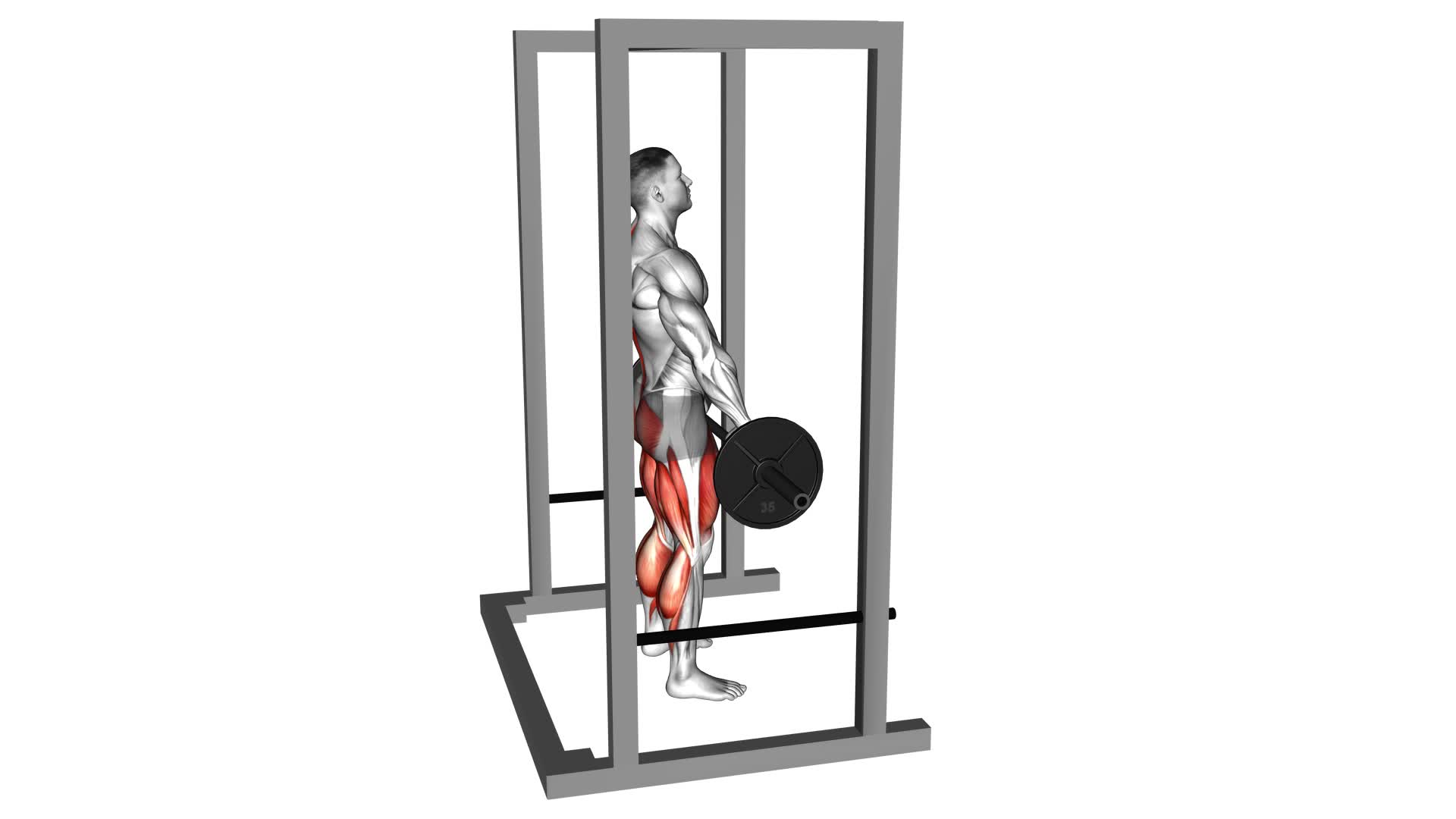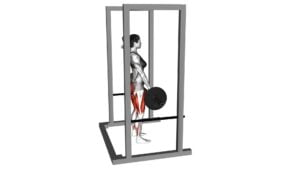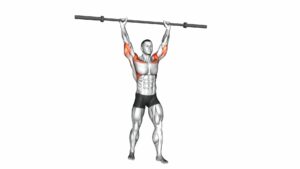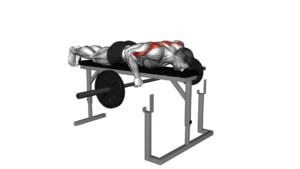Barbell Rack Pull – Video Exercise Guide & Tips

Looking to level up your strength training routine? Check out our video exercise guide and tips for the barbell rack pull.
Watch This Exercise Video
You'll learn the proper form and technique, discover variations to increase intensity, and avoid common mistakes.
Maximize your gains and prevent injury with these expert tips.
Get ready to challenge yourself and achieve new heights in your fitness journey.
Let's get started!
Key Takeaways
- Barbell rack pulls can lead to significant strength gains.
- They target specific muscle groups and improve grip strength.
- Rack pulls are a compound exercise that can improve deadlift performance.
- Proper form and technique, such as keeping the back straight and initiating the movement with a hip hinge, are essential for optimal results.
Benefits of Barbell Rack Pull
You will experience significant strength gains by incorporating barbell rack pulls into your workout routine. Barbell rack pulls are a versatile exercise that can be adapted to suit your fitness goals.
One of the benefits of barbell rack pulls is that they allow you to target specific muscle groups. By adjusting the height of the barbell, you can focus on different areas of your back, such as the upper or lower back.
Additionally, barbell rack pulls help to improve your grip strength, as you need to hold onto the heavy weight while performing the exercise. This can be particularly beneficial if you participate in sports that require a strong grip, such as rock climbing or martial arts.
Another advantage of barbell rack pulls is that they're a compound exercise, meaning they work multiple muscle groups at once. This makes them an efficient choice for those looking to maximize their training time.
Finally, barbell rack pulls can also help to improve your deadlift performance. By strengthening the muscles used in the deadlift, such as the lower back and hamstrings, you can increase your overall lifting power.
Proper Form and Technique
To perform the barbell rack pull with proper form and technique, focus on maintaining a strong and stable posture throughout the exercise. This will help ensure that you engage the correct muscles and prevent injury.
Here are three key tips to help you perfect your weightlifting technique and engage your back muscles effectively:
- Start by standing with your feet shoulder-width apart and position the barbell just above your knees on the rack. Your grip should be slightly wider than shoulder-width, with your palms facing down.
- As you lift the barbell, keep your back straight and chest up. Avoid rounding or arching your back, as this can put unnecessary strain on your spine.
- Engage your back muscles by initiating the movement with a slight hip hinge. Push your hips back and maintain a slight bend in your knees as you lift the barbell by extending your hips and squeezing your glutes.
Remember to exhale as you lift the weight and inhale as you lower it back down. By practicing these techniques, you won't only maximize the effectiveness of the barbell rack pull but also reduce the risk of injury and develop stronger back muscles.
Variations for Increased Intensity
To increase the intensity of the barbell rack pull, consider incorporating variations such as using resistance bands or performing the exercise on an elevated platform. These advanced techniques can help you activate your muscles in different ways and maximize your workout.
One way to increase the intensity is by using resistance bands. Attach the bands to the barbell and secure them to the rack. As you perform the rack pull, the bands will provide additional resistance, challenging your muscles even more. This helps to increase muscle activation and overall strength.
Another variation is to perform the barbell rack pull on an elevated platform. This can be done by placing weight plates or blocks under your feet. By elevating yourself, you increase the range of motion and target your muscles from a different angle. This variation also puts more emphasis on your lower back and hamstrings.
Incorporating these advanced techniques into your barbell rack pull routine can help you break through plateaus and reach new levels of strength. Remember to always maintain proper form and technique, and listen to your body to avoid injury. Stay consistent and gradually increase the intensity for optimal results.
Common Mistakes to Avoid
When performing the barbell rack pull, it's important to avoid common mistakes that can hinder your progress and increase the risk of injury. Proper execution is key to getting the most out of this exercise. Here are three common mistakes to avoid:
- Using too much weight: It can be tempting to load up the barbell with heavy weights, but using too much weight can compromise your form and increase the risk of injury. Start with a weight that allows you to maintain proper form throughout the movement.
- Rounding your back: Keeping your back straight is crucial during the barbell rack pull. Rounding your back not only puts extra strain on your spine but also reduces the effectiveness of the exercise. Focus on maintaining a neutral spine position throughout the movement.
- Neglecting proper setup: Proper setup is essential for performing the barbell rack pull correctly. Make sure the barbell is set at the appropriate height on the rack and position yourself in a way that allows for a full range of motion. Neglecting proper setup can lead to poor form and decreased gains.
By avoiding these common mistakes, you can ensure that you're performing the barbell rack pull safely and effectively.
Now, let's move on to the next section where we'll discuss tips for maximizing gains and preventing injury.
Tips for Maximizing Gains and Preventing Injury
To maximize your gains and prevent injury while performing the barbell rack pull, it's important to focus on proper form and technique. One key tip for maximizing gains is to avoid overtraining. While it may be tempting to push yourself to the limit every time you hit the gym, overtraining can lead to muscle fatigue, decreased strength, and even injury. It's important to listen to your body and give yourself enough time to recover between workouts.
Another important tip is to incorporate warm-up exercises into your routine. A proper warm-up helps to increase blood flow to the muscles, improve flexibility, and reduce the risk of injury. Before starting your barbell rack pull, spend a few minutes engaging in dynamic stretches and light cardio exercises. This will prepare your muscles and joints for the upcoming workout and help you perform the exercise with proper technique.
Frequently Asked Questions
How Many Sets and Reps Should I Do for Barbell Rack Pulls?
For optimal results with barbell rack pulls, it's recommended to perform 3-4 sets of 8-12 reps. This rep range promotes both strength and hypertrophy gains.
The weight you use should be challenging but manageable, allowing you to maintain proper form throughout the exercise.
Can Barbell Rack Pulls Help in Improving Deadlift Strength?
Incorporating barbell rack pulls into your strength training program can definitely help improve your deadlift strength. By targeting the upper portion of the lift, rack pulls allow you to overload the muscles and work on your lockout strength.
To perform them properly for maximal gains, set the barbell at knee height, grip it slightly wider than shoulder-width apart, and lift it by driving through your heels and engaging your glutes and hamstrings.
Remember to maintain proper form and gradually increase the weight to challenge yourself.
Are Barbell Rack Pulls Suitable for Beginners?
Barbell rack pulls can be suitable for beginners.
The barbell rack pull technique involves pulling the barbell from a rack at knee height, focusing on the upper body and back muscles.
This exercise helps beginners develop strength in their posterior chain and improve their deadlift performance over time.
The benefits of barbell rack pulls include increased grip strength, improved posture, and enhanced overall body stability.
It's important for beginners to start with light weights and focus on proper form to avoid injury.
How Often Should I Incorporate Barbell Rack Pulls Into My Workout Routine?
To effectively incorporate barbell rack pulls into your workout routine, it's important to consider the benefits they provide in a powerlifting program.
By performing this exercise, you can target your posterior chain muscles, improve grip strength, and enhance overall pulling power.
To ensure proper form and technique, position the barbell just below knee level on the rack, maintain a neutral spine, and engage your glutes and hamstrings as you lift.
Incorporating barbell rack pulls a few times a week can help you achieve optimal results in your strength training.
What Muscles Does the Barbell Rack Pull Primarily Target?
The barbell rack pull primarily targets your back muscles, including the erector spinae, traps, and lats. This exercise is great for building upper body strength and improving posture.
The benefits of barbell rack pulls include targeting specific muscle groups, increasing grip strength, and promoting overall muscle growth.
There are various variations of the barbell rack pull, such as the snatch grip rack pull or the deficit rack pull, which can further target different muscle groups and add variety to your workout routine.
Conclusion
In conclusion, the barbell rack pull is a beneficial exercise for strengthening the posterior chain and improving overall strength.
By maintaining proper form and technique, individuals can target specific muscle groups and maximize gains.
Adding variations to increase intensity can challenge the body and prevent plateaus.
It's important to avoid common mistakes and listen to the body to prevent injury.
Following these tips will help individuals maximize their gains and achieve their fitness goals.

Author
Years ago, the spark of my life’s passion ignited in my mind the moment I stepped into the local gym for the first time. The inaugural bead of perspiration, the initial endeavor, the very first surge of endorphins, and a sense of pride that washed over me post-workout marked the beginning of my deep-seated interest in strength sports, fitness, and sports nutrition. This very curiosity blossomed rapidly into a profound fascination, propelling me to earn a Master’s degree in Physical Education from the Academy of Physical Education in Krakow, followed by a Sports Manager diploma from the Jagiellonian University. My journey of growth led me to gain more specialized qualifications, such as being a certified personal trainer with a focus on sports dietetics, a lifeguard, and an instructor for wellness and corrective gymnastics. Theoretical knowledge paired seamlessly with practical experience, reinforcing my belief that the transformation of individuals under my guidance was also a reflection of my personal growth. This belief holds true even today. Each day, I strive to push the boundaries and explore new realms. These realms gently elevate me to greater heights. The unique combination of passion for my field and the continuous quest for growth fuels my drive to break new ground.







